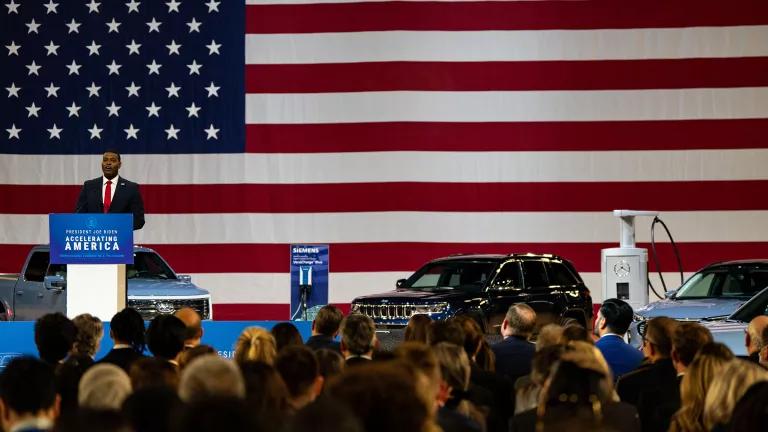Crash Course in Electrifying NJ’s Transportation Sector
New Jersey understands the task at hand and has been hard at work planning to decarbonize the transportation sector. The state’s goals are ambitious and strong, and if achieved, have the potential to significantly curb harmful emissions.
This blog is the first in a series that explores the state of electric vehicle policy in New Jersey. The series takes a deep dive into the transportation electrification policies New Jersey will need to meet its ambitious climate laws. Together, they explore whether New Jersey needs more ambitious transportation electrification goals, the state’s existing plans to realize their goals, and the next steps New Jersey should take to decarbonize its transportation system. Ultimately, this blog series aims to holistically examine electrifying all segments of the transportation sector.
Recapping Where New Jersey Is Today
It’s no secret that New Jersey has ambitious climate goals. With a mandate to achieve 100 percent carbon neutral energy generation and reduce its greenhouse gas emissions 80 percent by 2050, New Jersey has its work cut out. While emissions reductions are necessary across the board, transportation—which makes up 42 percent of the state’s emissions, the number one source of climate pollution in the state—will need to undergo a rapid transformation. During the Murphy administration, several initiatives and policies have been developed to help New Jersey achieve its goals, mostly focused on light-duty passenger vehicles. Understanding these initiatives is key to analyzing the opportunities New Jersey has to make even greater progress in decarbonizing its transportation system.
New Jersey has taken strong first steps towards transportation electrification. In 2018, Governor Murphy signed on to the Multi-State Zero-Emission Vehicles (“ZEV”) Task Force’s Memorandum of Understanding and decided to participate in the planning of the Transportation and Climate Initiative (TCI), a regional market-based transportation policy. Earlier this year, New Jersey released an Energy Master Plan (EMP) which lays out comprehensive goals for reaching its climate laws—including transportation electrification—and passed SB 2252 (“EV Law”) to jumpstart its electric vehicle progress. Several utilities in NJ have proposed electric vehicle (EV) programs, and the Board of Public Utilities (BPU) recently started a process to clarify the role of utilities in the EV space through a Straw Proposal. The New Jersey Department of Environmental Protection (DEP) and the BPU also have incentive programs for EVs and charging stations to increase the number of EVs on the road and ensure drivers have a place to charge at home and when travelling through the state.
Together, these plans create the backbone of New Jersey’s plan to decarbonize the land-based transportation sector. But are they enough? Below, we’ll see how New Jersey’s plans begin to address the six pillars to transportation electrification: charging infrastructure, electric vehicle incentives, utilities, equity, state fleet electrification and medium and heavy-duty vehicles.
New Jersey’s Six Pillars of Electrifying Transportation
Create Incentives for Electric Vehicles
New Jersey needs to encourage residents to replace their passenger cars and trucks with electric vehicles to fully reduce emissions in the transportation sector. The 2020 EV Law codified several goals surrounding EV ownership, calling for 330,000 passenger vehicles to be electric by 2025, 2 million to be electric by 2035, and 85 percent of all car sales to be electric by 2040. To achieve these numbers, New Jersey needs to provide support both to consumers looking to purchase vehicles, as well as car dealerships and fleets. Through the EV Law, New Jersey created a rebate program for consumers purchasing EVs, providing up to $5,000 per purchase. This rebate will be “point-of-sale,” which allows dealerships to roll the rebate into the customer’s purchase or lease price. New Jersey is also expanding its education campaign to increase awareness among customers and car dealers on the benefits of electric vehicles.
Charging Infrastructure
To support the state’s goal of 330,000 EVs on the road by 2025, New Jersey needs to expand its EV charging infrastructure. The EV Law set the goal of having 400 DC Fast Chargers and 1000 Level 2 chargers publicly available by 2025, with 15 percent of multi-family dwellings and 20 percent of overnight lodgings equipped with charging stations by the same date. The state’s Energy Master Plan (EMP) recognizes the need to deploy electric vehicle charging infrastructure to reduce “range anxiety,” ensuring drivers can travel throughout the state without the fear of running out of charge. To this end, New Jersey plans to develop best practices for localities installing EV charging stations to streamline installation timeframes. The Partnership to Plug-In, another electric vehicle program run by the DEP, will create a strategic roadmap to ensure that charging infrastructure is located in critical locations and provide rebates to reduce installation costs.
Utility Policy
Utilities have a unique and vital role in the EV space. This includes providing make-ready infrastructure for electric vehicles, in some use cases, owning and operating charging stations, considering sustainable rate design for EVs, and making sure that all customers have equitable access to clean transportation opportunities. The BPU recently released a Straw Proposal to develop these goals, which seeks to provide guidance on the role of utilities in the transportation electrification space. The Proposal also expands on how to fund charging infrastructure, how to ensure equitable access to charging infrastructure and which reforms to rate structures may be necessary. These goals, as well as a goal to optimize the grid by encouraging charging at low-demand times of day, are also articulated in the EMP.
Equity
Equity must be at the center of the transition to EVs and needs to be considered in all transportation electrification programs and incentives. The transition to electric vehicles should target emissions reductions in environmental justice communities that face disproportionately higher levels of air pollution and ensure that all residents have access to clean transportation options, regardless of whether they own a personal vehicle. The Partnership to Plug-In will establish incentives for charging stations and EV purchases for low-income and environmental justice communities by providing upfront incentives to reduce payments. NJ TRANSIT will prioritize additional electric bus early deployment programs in urban and environmental justice communities. Additionally, New Jersey aims to provide multi-modal accommodations to serve bicyclists and pedestrians and is seeking grants for projects on electric ride sharing and community charging hubs. It is also important to make sure EVs are doing most of their charging at night, when there is less demand for electricity. Doing so will help to reduce electricity costs for all utility customers, even if they don’t drive an EV.
State Fleet Electrification
New Jersey must lead by example by electrifying its state fleet vehicles and building out charging infrastructure on state-owned property. The EV Law requires 25 and 100 percent of non-emergency state passenger vehicles to be electric by 2025 and 2035, respectively. The EMP states that it will transition gas vehicles to electric as they reach the end of their useful lives. The EMP also requires that the state install EV chargers at state parking lots and garages, state parks, and other locations under its jurisdiction.
Medium and Heavy-Duty Electrification
While electrification of the light-duty sector is necessary, it is essential that New Jersey accelerate its medium- and heavy-duty vehicle electrification to fully attain its climate goals. By 2024, the EV Law requires that 10 percent of bus purchases made by New Jersey must be zero emission, and all bus purchases must be electric in 2032. Additionally, the EV Law requires New Jersey to develop goals for medium- and heavy-duty electrification by the end of the year. The EMP creates goals for NJ TRANSIT to determine how to integrate electric bus and charging infrastructure purchases into its procurement cycle. For medium- and heavy-duty fleets, New Jersey plans to look outwards and partner with industry to develop incentives for electrification and determine which vehicles should be incentivized as first adopters. New Jersey will also work with school bus fleets to encourage EV adoption to upgrade fleets.
The Road Ahead for New Jersey
As described above, New Jersey understands the task at hand and has been hard at work planning to decarbonize the transportation sector. The state’s goals are ambitious and strong, and if achieved, have the potential to significantly curb harmful emissions.
Now comes the hard part—it’s up to New Jersey to follow-through on its commitments to achieve transportation decarbonization. Thus far, we’ve looked at what New Jersey’s goals and initiatives look like at present. Next, we’ll look at how far these policies actually go, and what additional programs and policy recommendations are required for New Jersey to become a leader in vehicle electrification.



